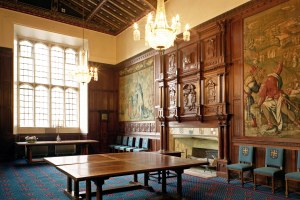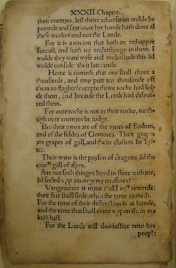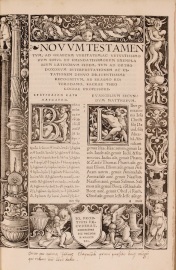Looking Back, and Far Ahead
I’m writing this from Borough High St. in Southwark (London), a few blocks from Southwark Cathedral, and in the vicinity of what used to be Winchester Palace, the London residence of the Bishop of Winchester. Lancelot Andrewes, translator of the King James Bible and perhaps supervisor of the First Westminster Company, was granted the bishopric in 1618. He is buried in Southwark Cathedral and is represented in effigy lying on top of his tomb.
London is full of reminders of the translation of the English Bible. Across London Bridge, which is just up the road and on the right, is the church of St. Magnus Martyr. Miles Coverdale, who translated the first complete English Bible (apart from the Wycliffites), is buried there, since he served for a time as rector.
William Tyndale, translator of translators, is buried in Vilvoorde in the Netherlands, where he was strangled and burned, but his sculpted head is included as a decorative architectural feature at St. Dunstan-in-the-West, where he lectured. John Donne later preached at St. Dunstan’s. A little south of St. Paul’s, where Donne was dean, stood the church of Holy Trinity the Less, destroyed in the Great Fire. John Rogers, the man responsible for Matthew’s Bible (1537), was rector there a few years earlier. He was later burned alive as a heretic at Smithfield, a 10 minute walk north, near the church of St. Bartholomew the Great. Benjamin Franklin worked briefly for a printer in the Lady Chapel of St. Bart’s.
Of course, Westminster itself, the location of two companies of the King James Bible translators, is down the Thames to the west. Thomas Bilson, Bishop of Winchester (before Andrewes), member of the Second Cambridge Company, and one of the revisers of the final King James Bible text, is buried in Westminster Abbey, as is, of course, King James I. Archbishop Matthew Parker, who supervised the translation of the Bishops’ Bible (1568), is buried at Lambeth just across the Thames.
The celebrations of the King James Bible anniversary have died down here. There are no upcoming events listed on the website of the King James Bible Trust. And in the United States, the tour of Manifold Greatness comes to end on July 12—oddly enough, my birthday. Perhaps more appropriately, it is the date of the death of Erasmus (1536), who produced the Greek text of the New Testament that became known as the Textus Receptus, an essential resource for translators from William Tyndale to the King James Bible companies.
As I reflect on the long history of Manifold Greatness, from its inception and planning, to the years of research, to the exhibition at the Folger, to the long journey of the panel exhibitions, I wonder what lies ahead for the King James Bible in 2111. Will the 500th anniversary be celebrated as were the 400th and the 300th? Will the King James Bible still be in use in some churches? Will American presidents still be sworn in on it? Will the King James Bible have an afterlife in the 21st century? Will some lecturer refer back to the 2011 anniversary celebrations at the Folger, as I referred in my opening lecture to celebrations in New York and London in 1911? Few of us will know. As Matthew writes, “of that day and that hour knoweth no man, no, not the angels which are in heaven, neither the Son, but the Father.”
Hannibal Hamlin, associate professor of English at The Ohio State University, was co-curator of the Manifold Greatness exhibition at the Folger Shakespeare Library.
Tyndale, Quills, and Ink: Manifold Greatness Opens at the Tuscaloosa Public Library

Young community members make feather quills and sign their names with blackberry ink. Photos by Vince Bellofatto.
On March 8, the City of Tuscaloosa welcomed the Manifold Greatness traveling exhibit to the Tuscaloosa Public Library, a highly anticipated event in a region that lies in the heart of the Bible Belt.
Five displays, which were curated by the library, are scattered throughout the building to enhance the Manifold Greatness experience. These displays offer visitors the chance to experience physical representations of the topics discussed within the Manifold Greatness exhibit, such as the history of books, papermaking, bookmaking, the literary influence of the King James Bible, and what the Bible has become today.
Our family-friendly opening reception was held Sunday, March 10. Attendees were given the chance to peruse the exhibit while enjoying the classical music of Handel’s Messiah and partaking of light refreshments. The keynote speaker, Dr. L. Jeffrey Weddle, Associate Professor at the University of Alabama, introduced the history of the first English Bibles through William Tyndale’s version during his presentation, entitled “William Tyndale: How His Bible Translation Changed the Reformation and Led to the King James Version.”
As an added bonus, the Children’s Department gave patrons a guided tour through the history of bookmaking, starting with a discussion of early bookmaking and the various materials that have been used to make books, followed by a feather quill making activity. After reading the story The Ink Garden of Brother Theophane by C.M. Millen, participants saw a demonstration of making blackberry ink and were able to use their new quills to sign their names.
From there, they were offered the opportunity to hear from Christopher Davenport and Laura Rowley, students from the University of Alabama Book Arts Department, with lessons and hands-on activities on letterpress printing, bookmaking, and papermaking.
In the coming weeks, the library is looking forward to the many special groups scheduled to attend the exhibit and will be hosting two additional programs geared towards engaging our community in the history and influence that the creation of the King James Version had on the world.
Susana Goldman is Reference Librarian at the Tuscaloosa Public Library in Tuscaloosa, Alabama.
Final Days and Beautiful Sunshine for the Folger Exhibition
 It will be tough to say goodbye to the Folger Manifold Greatness exhibition after this Monday (in the words of Juliet, “Parting is such sweet sorrow”)… but we hope to see you before it goes!
It will be tough to say goodbye to the Folger Manifold Greatness exhibition after this Monday (in the words of Juliet, “Parting is such sweet sorrow”)… but we hope to see you before it goes!
The Folger exhibition is open today (Saturday), Sunday, and Monday; admission is free. And we’re delighted to have started the last weekend of the exhibition with brilliant sunshine.
Some of the many “don’t miss” items now on display in the Folger exhibition include:
• An Anglo-Saxon manuscript from about the year 1000 that retells biblical stories in epic verse
• A rare Wycliffite Bible from the 1380s
• A 1530 fragment from William Tyndale’s contraband biblical translations, discussed by Hannibal Hamlin in this post: Tyndale was executed in 1536
• Queen Elizabeth’s 1568 Bishops’ Bible
• A Bodleian copy of a 1602 Bishops’ Bible annotated with translators’ changes
• The Folger first edition of the King James Bible
• The Prince Henry Bible, an elaborately bound copy of the King James Bible owned by James I’s older son, Prince Henry, who died in 1612
• A “Wicked” Bible (1631) in which the printer omits a key word from the commandment on adultery
• A King James Bible that came over on the Mayflower
• King James Bibles owned by Frederick Douglass and Elvis Presley
• Early family Bibles, with century-old handwritten records of births, christenings, and other events, including the Hamlin Family Bible
And what story does it all tell? In the words of the Washington Post from last September:
The exhibition includes fascinating mysteries, epic battles, stake burnings and other enthralling episodes in the lives of the men involved in Bible translation. It covers the events that led to the birth of the King James, as well as the book’s influence on art, literature, popular culture, music and history—from Handel’s “Messiah” to the reading of Genesis by the astronauts aboard Apollo 8, a broadcast heard by a quarter of the people on Earth at the time, making the Bible’s reach literally astronomical.
The New York Times (also in September) put it this way:
Pay close attention to the major new exhibition at the Folger Shakespeare Library here, “Manifold Greatness: The Creation and Afterlife of the King James Bible,” and you will see not only manuscripts going back to the year 1000, an early translation from the 14th century, Queen Elizabeth I’s copy of the Bible, and imposingly bound versions of the King James; you will also sense the gradual birth of the modern English language and the subtle framing of a culture’s patterns of thought… you cannot survey the riches at the Folger without realizing that you are being given a glimpse of a culture’s birth.
In his recent blog post about an American Civil War POW’s King James Bible, curator Steve Galbraith noted “the long reach of the King James Bible and how much history was covered by our one exhibition.” Another reminder of those historical KJB associations comes this weekend, with the Martin Luther King, Jr., holiday on Monday and Dr. King’s actual birthday on Sunday. Curator Hannibal Hamlin wrote about Martin Luther King and the King James Bible last August, and King is recognized in the Folger exhibition as well. On Monday, the exhibition’s last day, the Folger Shakespeare Library also offers a free, family-friendly event for the King holiday on the theme of protest. And once again, the King James Bible of 1611 traces its connections to the present day.
Touchstone Moments for the Folger Exhibition
You might think that exhibitions at the Folger Shakespeare Library are all about books and manuscripts and art—and you’d be right. But precisely because these types of paper-based artifacts can be challenging to display in new and engaging ways, I encourage curators to look for other types of objects to reflect the content and themes of each exhibition. For Manifold Greatness, we were presented with a rich and interesting topic, but one that was explicitly about a single book. One of the goals was to make this 400-year-old book come alive with human stories about its creation and its afterlife, so curators Steve Galbraith and Hannibal Hamlin began brainstorming with me about how to do that with a series of “touchstone moments” around the Great Hall.
Hannibal wanted a scene all about the sounds of the King James Bible, and for this, we borrowed a pew and lectern from the Lutheran Church of the Reformation. With a nineteenth-century Bible on the lectern, and a listening station with an interactive feature from the website, exhibition-goers can hear short, familiar passages read aloud by actors, as well as commentary from Hannibal and Steve.
Across the hall is a family Bible scene that brings to mind nineteenth-century households where the King James Bible was a fixture in the lives of many American and English families. Here, a nineteenth-century Bible sits open on a table, with candlesticks for light, and a pair of reading glasses. Touring the exhibition recently, a colleague said to me, “The spectacles really make this one come alive.”
A mid-twentieth-century parlor radio (photo, above) and a postcard from the Moody Bible Institute comprise a third touchstone. The Moody Bible Institute in Chicago, which began broadcasting Moody Radio in the 1920s, remains one of the largest Christian radio stations in the country. Its greatest popularity was in the 1950s and 60s, and we included it as an example of the more contemporary influences of the King James Bible in American culture.
Perhaps the most challenging touchstone in Manifold Greatness is the very first one. Our case on martyrs and heretics explores early English Bible translators like John Wyclif, William Tyndale, Miles Coverdale, and John Rogers. A wall panel displays woodcuts from John Foxe’s Actes and Monuments that depict the grisly fates some of these translators met. Tyndale and Rogers were both burned at the stake, and Wyclif’s bones were exhumed and burned in the late fifteenth century.
When Steve Galbraith walked into my office and suggested it would really make a statement to have our own stake at this point in the exhibition, I wasn’t sure what to think—or how we’d manage it. But with a small tree, a few bundles of twigs, a friend at the Smithsonian who gave us access to a large freezer (to make sure nothing was alive in that small tree or those bundles of twigs), a handy technical director in the Folger Theatre, and some creative camouflage painting by our Folger conservators, we built a modest stake right there in the Great Hall.
While we don’t intend to burn anyone at our touchstone stake, we hope these vignettes make the exhibition come alive for visitors, and draw them into its unique world. Come see for yourself!
The Manifold Greatness exhibition is open through January 16 at the Folger Shakespeare Library in Washington, DC. Admission is free. See our Tips for Visitors blog post for more information.
Caryn Lazzuri is exhibitions manager at the Folger Shakespeare Library and has previously written about previewing the traveling exhibit at the ALA annual meeting in New Orleans and installing the Folger Manifold Greatness exhibition.
Record attendance for Bodleian Manifold Greatness exhibition
 The Bodleian’s Manifold Greatness exhibition closed its doors on Sunday 4 September, with visitors still savouring their chance to encounter its exhibits right up to the last moment. The final attendance figure was 58,024 – a record for a Bodleian exhibition – and the whole team here is delighted at the response the exhibition has drawn. Many local people have enjoyed the chance to learn more about Oxford’s connections with Bible translation – from Wyclif, to Tyndale, the KJB translators, and beyond – and early in the exhibition’s run this connection was given a slot on the prime-time local TV news. The exhibition has also been covered in the Oxford Times and on BBC Radio Oxford. Visitors have been drawn from all over the globe, and comments have been left in the visitors’ book in many different languages. The meeting of different cultures and languages through the act of Bible translation was one of the themes of the exhibition, and so it is very apt that the exhibition itself should have become a place of so many local, national and international encounters with the story of the KJB.
The Bodleian’s Manifold Greatness exhibition closed its doors on Sunday 4 September, with visitors still savouring their chance to encounter its exhibits right up to the last moment. The final attendance figure was 58,024 – a record for a Bodleian exhibition – and the whole team here is delighted at the response the exhibition has drawn. Many local people have enjoyed the chance to learn more about Oxford’s connections with Bible translation – from Wyclif, to Tyndale, the KJB translators, and beyond – and early in the exhibition’s run this connection was given a slot on the prime-time local TV news. The exhibition has also been covered in the Oxford Times and on BBC Radio Oxford. Visitors have been drawn from all over the globe, and comments have been left in the visitors’ book in many different languages. The meeting of different cultures and languages through the act of Bible translation was one of the themes of the exhibition, and so it is very apt that the exhibition itself should have become a place of so many local, national and international encounters with the story of the KJB.
Helen Moore is Fellow and Tutor in English at Corpus Christi College, Oxford. She chaired the Oxford ‘Manifold Greatness’ curatorial committee.






















